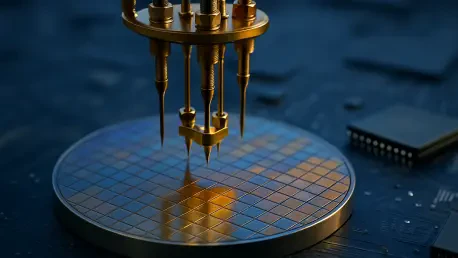Semiconductors, often referred to as the building blocks of modern technology, have transcended their traditional role in powering computers and smartphones to become the driving force behind a sweeping transformation across multiple sectors. These microscopic marvels, capable of processing vast amounts of data at unprecedented speeds, are redefining industries such as automotive, healthcare, the Internet of Things (IoT), and quantum computing. Their ability to shrink in size while amplifying power and efficiency is unlocking innovations that were once the stuff of imagination, from self-driving cars to life-saving medical devices. Today, semiconductors are not just components; they are strategic enablers shaping the future of global economies and societal progress. This exploration delves into the profound ways these tiny chips are catalyzing change, examining the core drivers of their surge, the specific impacts on key industries, and the challenges that accompany this technological revolution. As the world becomes increasingly interconnected and reliant on intelligent systems, understanding the role of semiconductors offers critical insight into the trajectory of innovation and the hurdles that must be navigated to sustain this momentum.
The Forces Fueling Semiconductor Innovation
The semiconductor industry is undergoing a remarkable evolution, propelled by an unrelenting focus on efficiency and miniaturization. These tiny chips are being engineered to deliver greater performance in smaller packages, slashing energy consumption while fitting into the most compact devices. In electric vehicles (EVs), for instance, cutting-edge materials like silicon carbide (SiC) and gallium nitride (GaN) are enhancing power electronics, extending driving ranges, and reducing the bulk of battery systems. This push for efficiency isn’t just a technical achievement; it’s making sustainable solutions more practical and accessible across various applications, ensuring technology integrates seamlessly into everyday life.
Another pivotal force is the shift toward specialized semiconductor designs tailored to meet the unique demands of different sectors. Gone are the days of generic chips; today’s semiconductors are crafted for specific tasks, whether it’s enabling real-time data processing in autonomous vehicles or supporting ultra-low-power operations in IoT sensors. This customization addresses the growing complexity of technological needs, ensuring that industries can harness the full potential of digital advancements. Such specialization highlights how semiconductors are evolving from mere hardware into critical tools that drive sector-specific innovation, setting the stage for groundbreaking applications.
Beyond technical advancements, semiconductors have emerged as strategic assets with far-reaching economic and geopolitical implications. They are the backbone of emerging markets like smart infrastructure and personalized healthcare, while also influencing global competition as nations vie for technological dominance. Governments and corporations are investing heavily to secure supply chains and maintain leadership in this space, recognizing that control over semiconductor technology equates to influence over future progress. However, this rapid expansion is not without obstacles, as supply chain volatility, cybersecurity threats, and ethical dilemmas pose significant risks, underscoring the need for robust strategies to balance innovation with responsibility.
Transforming the Automotive Sector
The automotive industry stands at the forefront of a semiconductor-driven revolution, with these chips powering the transition to electric and autonomous vehicles. In EVs, advanced semiconductors optimize power management, using materials like SiC to improve inverter efficiency and extend vehicle range while minimizing battery size. Meanwhile, Advanced Driver Assistance Systems (ADAS) rely on high-performance processors and sensors such as LiDAR and radar to enable real-time navigation and safety features. This technological leap is redefining mobility, moving away from traditional mechanical systems toward a future where vehicles are smarter, safer, and more sustainable, all thanks to the capabilities embedded in these tiny components.
Equally transformative is the rise of software-defined vehicles, a trend made possible by semiconductor advancements. Modern cars are evolving into sophisticated computing platforms, with updatable software and customizable features that enhance user experience. This shift reorients the industry’s value proposition from hardware to electronics and digital ecosystems, fostering unprecedented collaborations between automakers and semiconductor manufacturers. Companies like NVIDIA and Intel are playing pivotal roles in providing AI accelerators for autonomous driving, illustrating how the integration of specialized chips is not just enhancing vehicle functionality but also reshaping business models within the sector.
Despite these advancements, significant challenges loom over the automotive industry’s reliance on semiconductors. Supply chain disruptions have exposed vulnerabilities, causing production delays for many manufacturers. Additionally, the increasing connectivity of vehicles heightens cybersecurity risks, as hackers could exploit vulnerabilities in critical systems. Ensuring the reliability of autonomous technologies remains paramount, as any malfunction could have catastrophic consequences. Addressing these issues requires stringent safety standards and innovative solutions to protect data and maintain consumer trust, highlighting the complex balance between progress and precaution in this rapidly evolving field.
Powering the Internet of Things (IoT) Ecosystem
In the realm of the Internet of Things, semiconductors serve as the critical enablers of a hyper-connected world, linking billions of devices with seamless efficiency. Low-power microcontrollers and sensors form the foundation of IoT applications, from smart home gadgets like thermostats to industrial monitoring systems that optimize factory operations. These chips ensure devices operate with minimal energy consumption, making it feasible to deploy them on a massive scale. As a result, urban environments and personal spaces are transforming into intelligent ecosystems where data-driven decisions enhance convenience, productivity, and sustainability.
A significant advancement within IoT is the adoption of edge computing, facilitated by semiconductors with embedded AI accelerators. By processing data locally rather than relying on distant cloud servers, edge computing reduces latency and boosts responsiveness, which is crucial for time-sensitive applications like predictive maintenance in industrial settings or real-time traffic management in smart cities. This capability not only improves performance but also alleviates bandwidth strain on networks, showcasing how semiconductors are pivotal in addressing the scalability challenges of IoT. The integration of such advanced functionalities into compact chips underscores their role in pushing the boundaries of what connected devices can achieve.
However, the proliferation of IoT devices brings with it a host of challenges that must be navigated carefully. Data privacy remains a pressing concern, as the vast amount of information collected by these devices is vulnerable to breaches. The push for ultra-small form factors also strains manufacturing processes, raising questions about long-term reliability, especially in harsh or remote environments. Moreover, supply chain constraints for specialized components can hinder deployment timelines. Tackling these issues demands a focus on robust security protocols and innovative design solutions to ensure that the promise of a connected world does not come at the expense of safety or trust.
Advancing Healthcare Through Precision Technology
Healthcare is experiencing a profound transformation driven by semiconductors, particularly through the development of wearable devices and implantable technologies. Miniaturized biosensors embedded in smartwatches and medical implants can monitor vital signs such as heart rate and glucose levels in real time, empowering patients and doctors with continuous health data. This shift brings hospital-grade monitoring into the home, enabling early detection of issues and reducing the need for frequent clinical visits. The precision and portability of these devices are directly tied to advancements in semiconductor technology, illustrating their vital role in enhancing patient outcomes.
Beyond wearables, semiconductors are revolutionizing diagnostics and treatment through specialized integrated circuits (ICs) that power portable imaging tools and point-of-care testing equipment. These innovations make advanced medical services more accessible, particularly in underserved regions where traditional infrastructure is limited. By facilitating rapid and accurate diagnostics, such as handheld ultrasound devices or blood analysis systems, semiconductors are paving the way for personalized medicine tailored to individual needs. This capability not only improves care quality but also reduces costs, demonstrating how deeply these chips are reshaping the healthcare landscape with practical, life-changing applications.
Nevertheless, integrating semiconductors into healthcare is fraught with challenges that require careful consideration. Regulatory hurdles for AI-powered medical devices can delay deployment, as ensuring safety and efficacy is non-negotiable. Data security is another critical issue, given the sensitive nature of health information collected by connected devices. Additionally, power constraints for tiny implantables necessitate ongoing innovation to extend battery life without compromising functionality. Addressing these barriers calls for collaboration between technologists, regulators, and healthcare providers to establish standards that protect patients while fostering the adoption of cutting-edge solutions.
Pioneering the Frontier of Quantum Computing
Quantum computing represents the cutting edge of semiconductor application, promising to tackle problems that classical computers cannot solve. Semiconductors are integral to creating qubit architectures, such as superconducting circuits and silicon spin qubits, which form the basis of quantum systems. Major players like Intel and IBM are leveraging their expertise in silicon fabrication to develop chips capable of controlling delicate quantum states, opening doors to breakthroughs in fields like drug discovery, cryptography, and materials science. Though still in early stages, the potential of this technology to redefine computational paradigms is immense, driven by the precision of semiconductor engineering.
The road to practical quantum computing, however, is laden with formidable obstacles that temper the excitement surrounding it. Maintaining quantum coherence—the stability of quantum states—requires extreme conditions like cryogenic cooling, posing significant infrastructure challenges. Error correction remains a complex puzzle, as quantum systems are highly susceptible to interference. Furthermore, the scarcity of specialized talent in this nascent field slows progress. While the long-term vision includes solving intractable problems, current efforts focus on hybrid classical-quantum approaches to achieve incremental gains, underscoring the experimental nature of this domain and the critical role semiconductors play in its evolution.
Looking ahead, the journey of quantum computing will hinge on scaling qubit systems and improving their stability, areas where semiconductor advancements will be indispensable. Near-term expectations center on achieving quantum advantage in specific applications, such as optimizing complex algorithms for industries facing massive data challenges. The competitive landscape, featuring tech giants alongside innovative startups like IonQ, signals a race to unlock this transformative power. Despite the hurdles, the integration of semiconductors into quantum architectures offers a glimpse into a future where computation transcends current limits, potentially reshaping entire sectors with solutions once deemed impossible.
Shaping a Smarter Tomorrow with Silicon
Reflecting on the remarkable strides made, it’s evident that semiconductors have become the linchpin of technological progress across diverse industries by this point in time. Their integration into automotive systems has redefined mobility, making electric and autonomous vehicles a tangible reality with enhanced safety and efficiency. In healthcare, they have empowered a shift toward personalized care through wearable and diagnostic innovations, improving lives with unprecedented precision. The IoT landscape has been transformed by their ability to connect and process data at the edge, creating intelligent environments that optimize daily operations. Even in the nascent field of quantum computing, semiconductors have laid the groundwork for computational breakthroughs that promise to solve once-insurmountable challenges.
Moving forward, the focus must shift to actionable strategies that address the persistent challenges of supply chain resilience, cybersecurity, and ethical considerations that span all sectors. Collaborative efforts between industries and policymakers should prioritize the development of secure, standardized frameworks to protect data and ensure equitable access to these technologies. Investment in research for sustainable materials and energy-efficient designs will be crucial to support the next wave of semiconductor innovation. As new chip architectures emerge and strategic partnerships form, the coming years will likely witness deeper integration of AI with hardware, further amplifying the capabilities of intelligent systems. This ongoing silicon journey demands a balanced approach, ensuring that the benefits of ubiquitous technology are realized responsibly and inclusively for global advancement.









